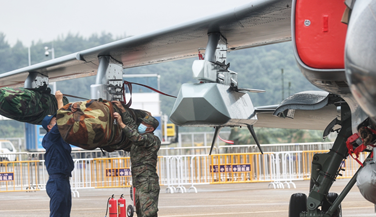
AKF98A on JH-7A fighter bomber.
SINGAPORE–China continues to tease its air launch munition advancements and capabilities at the Zhuhai Airshow here, this time featuring at least three new systems, including a never-before-seen standoff weapon, the AKF98A.
Resembling the AGM-158 Joint Air-to-Surface Standoff Missile (JASSM) and the AGM-154 Joint Standoff Weapon (JSOW), the AKF98A was seen fitted on the Shenyang J-16D electronic warfare fighter and Xian JH-7A2 fighter-bomber. The weapon was observed with a jet exhaust, although an air scoop inlet was not seen, likely designed to be flushed to the missile’s base. The polygon-shape nose is also designed to reduce radar cross signature. Local analysts estimate the weapon to have a range of between 500-1,000 km (310.6-621.3 mi.).
Other new standoff weapons displayed at Zhuhai include the TS-20, developed by UAS manufacturer Tengden.
A Xian H-6K bomber was also observed carrying a pair of new missiles, labeled 2PZD-21. Already known to be capable of carrying the DF-21 ballistic missile, the 2PZD-21 appears to be a miniaturized variant of the “carrier killer.” The shape and profile follows the B-611/CM-401 short range ballistic missile, with a reported maximum terminal speed of Mach 6 at a 290 km range, although an air launched variant will greatly extend its maximum reach.
Such standoff weapons are among China’s recent drive to bring the People’s Liberation Army Air Force to global and Western standards, not only for its own military benchmarking, but also to fulfill potential customers’ requirements. These weapons will also allow PLAAF aircraft to possess area denial capabilities while within the protection of Chinese air defense systems.



